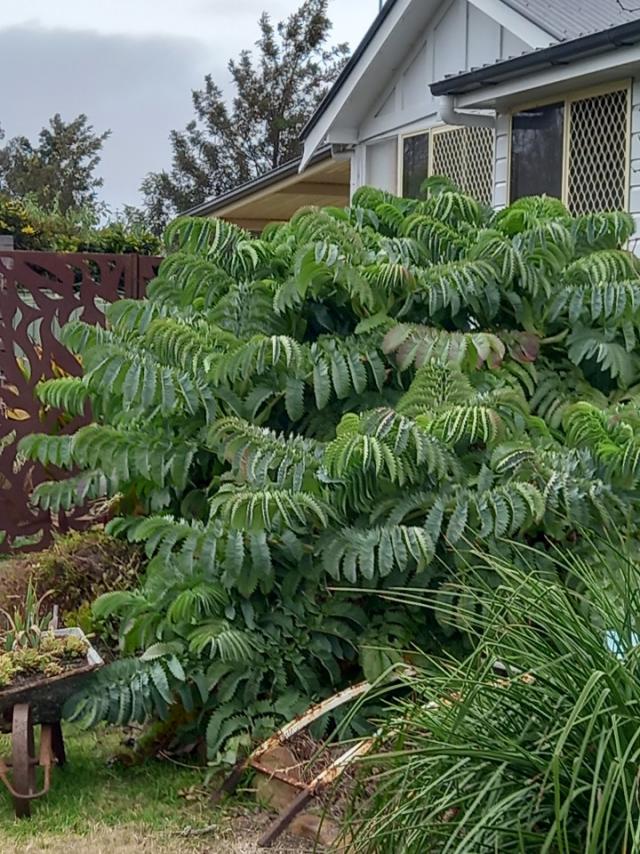As I am writing this the Jumpers and Jazz Festival is off to a great start with beautiful weather on Sunday for the car spectacular in Palmerin Street. Having grown up in the 50s with older brothers I guess I have always been a bit of a “rev head”! Each year of the festival since I’ve lived in Warwick I’ve treated myself to a trip down memory lane on the first Sunday morning of the festival with a walk down Palmerin Street and now also Leslie Park. Thank you to all the dedicated people who preserve motoring history so beautifully and with such pride and allow us to enjoy their treasures.
Driving around town recently after the heavy frosts we’ve been having I was astounded to see a very “tropical” looking tree in a garden in Percy Street.
With further investigation, I discovered it is a “melianthus major” or commonly, “honey bush”. It is native to South Africa where it is considered a roadside weed, and does well in Australia as do so many other beautiful plants from there. In fact, it does so well here that it has naturalised, is a problem and declared noxious in some southern areas!
It is a fast-growing perennial that can reach 3 to 5 metres and about 1.5 wide. It reproduces by seed and suckers! Supposedly it doesn’t like frosts, but the one I saw is flourishing at the moment and is not in a sheltered position, and I’ve experienced some of the hardest frost this year since I arrived in Warwick. It has large grey-green leaves and looks like something you’d find growing in a tropical/jungle garden further north.
Apparently, it has spectacular, highly perfumed and nectar-filled large spikes of red to brown flowers in spring and summer, hence the common name “honey bush”! These sprays of flowers, up to about 80 cm in length, stand well above the bush itself and make a great statement. Another common name is “touch-me-not” and this may be because, when you crush the leaves, they give off an unpleasant odour.
It likes a position in full sun to a little shade, nice rich, moist soil and can be pruned each year in winter. If heavily pruned, and it is suggested it can be cut back to within a few inches of the ground, flowering will not be as good as if you only trim it to keep it under control. It can be successfully grown in a pot apparently, but my suggestion would be that it would need to be a very large pot!! It would not be something to try if you only had a small area either in a pot or open ground. Having said that, there is a smaller form called “purple haze”, that might be worth a try. It would certainly give a lush tropical look to a patio.
Opinions seem divided as to how toxic it is but all agree that animals won’t eat it unless there is nothing else around because of the smell of the leaves when brushed against, so fairly safe around your dogs and cats. It is also suggested that the roots are particularly poisonous if eaten and have killed people in Africa where it is used in tribal medicine!
Another plant that I would love to grow if I had unlimited acreage and finance and full time gardeners to help with the upkeep!
Despite the severity of the frosts my lawn is still growing and is in need of cutting again. I am going to endeavour to do this myself this week sometime before my brother arrives and is horrified by it! Windows are also going to be done this week for the same reason!!
Another plant that is providing colour at this time is the trumpet vine and my small one on the back fence is flowering nicely. I had it in a pot until last summer and it has appreciated the move into the ground and progressed nicely up the mesh provided and is flowering for the first time. I am aware that it can become a problem and aim to keep it pruned back and contained. My memories are of seeing it in glorious bloom covering old dairy sheds on the north coast of N.S.W.
Of course, we also have the beauty of camellias flowering now and they do look beautiful in all the beautiful shades from white through pale pink to lovely reds..sasanquas and japonicas alike are really lovely to see.
The Camellia sasanqua varieties appear to be the hardiest and the fastest growing, are more sun tolerant, can handle heat and humidity better but are also fine in heavy shade. They make a great hedge and will establish reasonably quickly. However, I have memories of a very large camellia “tree” about 15 feet high covered in the palest pink flowers that entranced me as a child. It was definitely a japonica and it will always remain a favourite.







